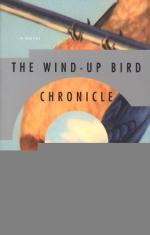|
This section contains 537 words (approx. 2 pages at 300 words per page) |

|
SOURCE: A review of The Wind-Up Bird Chronicle, in World Literature Today, Vol. 73, No. 2, Spring, 1999, p. 389.
In the following review, Samuel highlights the postmodern conventions of The Wind-Up Bird Chronicle, comparing its style to that of Thomas Pynchon and Don DeLillo.
Published half a century after the end of Japan's fifteen-year war that began with the seizure of Manchuria in 1931, the voluminous narrative (1,156 pages in three volumes in Japanese) The Wind-Up Bird Chronicle probes the meaning of time, memory, and self-actualization in the “high-tech” age. Haruki Murakami spices this postmodern work with elements of science fiction, in a manner reminiscent of works by such cyberpunk writers as Thomas Pynchon and Don DeLillo.
The first-person narrator of the story is a thirty-year-old man with only a thin sense of subjectivity. Having left his job for no specific reason, he idles his time away, while “the wind-up bird” winds “the...
|
This section contains 537 words (approx. 2 pages at 300 words per page) |

|


